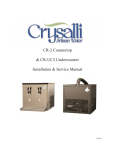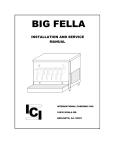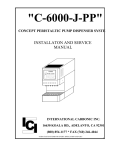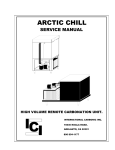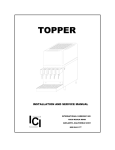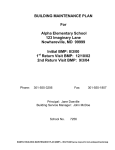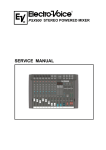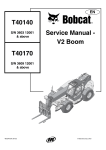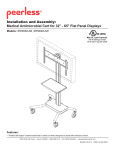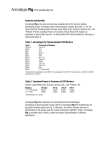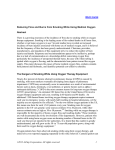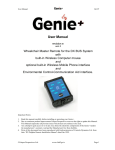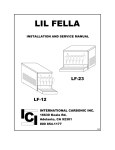Download Owner`s Manual - Crysalli | Artisan Water
Transcript
CR-2 Countertop & CR-UCM2 Undercounter Installation & Service Manual 6313 IMPORTANT: This manual is a guide for installing, operating, servicing and maintaining this equipment. Refer to Table of Contents for page location of detailed information to answer questions that arise during installation, operating, service and maintenance, or installation of this equipment. TABLE OF CONTENTS PAGE PREFACE ........................................................................................................................... 1 CHAPTER I GENERAL DESCRIPTION ............................................................................. 2 SYSTEM DESCRIPTION ....................................................................................... 2 DESIGN DATA ....................................................................................................... 3 MODEL LINE DRAWINGS………………………………………………………………4 CR-2 EXPLODED VIEW ........................................................................................ 5 DESCRIPTION, EXPLODED VIEW, CR-2 ............................................................ 6 CR-UCM2 EXPLODED VIEW ................................................................................ 8 DESCRIPTION, EXPLODED VIEW, CR-UCM2 .................................................... 9 COMMON PARTS LIST………………………………………………………………..11 ELECTRICAL SCHEMATIC, DUAL CARB, DIRECT WIRE ................................ 12 ELECTRICAL SCHEMATIC, S-68-B ................................................................... 12 THEORY OF OPERATION .................................................................................. 14 CHAPTER II INSTALLATION ........................................................................................... 17 UNPACKING AND INSPECTION ........................................................................ 17 SELECTING LOCATION ..................................................................................... 17 LOCATION RECOMMENDATIONS AND HINTS ................................................ 18 SAMPLE INSTALL DRAWING………………………………………………………...18 CR-UCM2 INSTALLATION .................................................................................. 20 CR-UCM2 INSTALL DIAGRAM……………………………………………………….21 CR-2 INSTALLATION…………………………………………………………………..22 CR-2 INSTALL DIAGRAM……………………………………………………………..23 INSTALL HIGH PRESSURE CO2 REGULATOR, CO2 CYLINDER AND LINES .......................................................................................................... 24 INSTALL WATER FILTER ASSEMBLY............................................................... 25 INSTALL WATER PRESSURE REGULATOR, (OPTIONAL) ............................. 25 INSTALL DRAIN LINE ......................................................................................... 26 CONNECTING WATER INLET ............................................................................ 26 CONNECTING CBR-V2C DRAFT TOWER…………………………………………27 ELECTRICAL REQUIREMENTS ......................................................................... 28 CHAPTER III PREPARATION .......................................................................................... 29 PREPARING SYSTEM FOR OPERATION ......................................................... 29 PREPARING AND STARTING REFRIGERATION UNIT .................................... 29 ACTIVATE HIGH PRESSURE CO2 SYSTEM .................................................... 29 ADJUST WATER FLOW RATE ........................................................................... 29 CHAPTER IV OPERATORS INSTRUCTIONS ................................................................. 30 DAILY PRE-OPERATION CHECK ...................................................................... 30 REPLENISHING CO2 SUPPLY ........................................................................... 30 COOLING UNIT MAINTENANCE ........................................................................ 30 CHECKING WATER BATH.................................................................................. 30 CHANGING WATER BATH ................................................................................. 31 ADJUSTMENTS ................................................................................................... 31 ADJUSTING WATER FLOW RATE..................................................................... 31 TESTING FOR LEAKS ........................................................................................ 31 SETTING AND ADJUSTING SELF SERVE X0101-HEX FAUCET..……………..32 CHAPTER V SERVICE AND MAINTENANCE ................................................................. 33 PERIODIC INSPECTION AND CLEANING......................................................... 33 DAILY CLEANING………………………………………………………………………33 WEEKLY CLEANING…………………………………………………………………...33 MONTHLY CLEANING…………………………………………………………………33 CR-UC2 CABINET MAINTENANCE .................................................................... 34 TABLE OF CONTENTS (cont’d) ................................................................ PAGE CR-2 CABINET MAINTENANCE……………………………………………………...34 CLEANING CONDENSER COIL ......................................................................... 34 CHECKING/CHANGING WATER BATH ............................................................. 35 WATER PUMP MAINTENANCE ......................................................................... 36 CARBONATOR MAINTENANCE ........................................................................ 37 SERVICING CHECK VALVES ............................................................................. 37 REPLENISHING CO2 SUPPLY ........................................................................... 40 CHANGING WATER FILTER CARTRIDGE ........................................................ 40 ADJUSTMENT OF CO2 REG .............................................................................. 40 SANITIZING PROCEEDURES ............................................................................ 41 CHAPTER VI TROULBESHOOTING ............................................................................... 42 CARBONATOR .................................................................................................... 42 WATER PUMP MOTOR WILL NOT OPERATE ..................................... 42 WATER PUMP MOTOR WILL NOT SHUT OFF .................................... 42 WATER PUMP WILL NOT SHUT OFF AND PRESSURE RELIEF ENGAGED................................................................................. 42 SHORT CYCLING OF WATER PUMP MOTOR .................................... 42 WATER PUMP CAPACITY TOO LOW................................................... 42 WATER PUMP OPERATES BUT WATER PUMP DOES NOT PUMP ............................................................................................. 42 FROZEN WATER BATH ......................................................................... 43 COOLING OR CONDENSING UNIT NOT OPERATIONAL ................... 43 AGITATOR MOTOR NOT OPERATING ................................................ 43 COMPRESSOR DOES NOT OPERATE ................................................ 43 COMPRESSOR WORKS CONTINUOUSLY BUT DOES NOT FORM SUFFICIENT ICE BANK ..................................................... 43 COMPRESSOR WILL NOT STOP AFTER SUFFICIENT ICE BANK IS PRODUCED ..................................................................... 44 CONDENSER FAN MOTOR NOT OPERATING ................................... 44 NO WATER BEING DISPENSED ........................................................... 44 DISPENSED PRODUCT CARBONATED TO LOW ............................... 44 DISPENSED PRODUCT MAKES FOAM AS IT LEAVES NOZZLE .................................................................................................. 45 DISPENSED PRODUCT COMES OUT CLEAR BUT FOAMS WHEN IT TOUCHES CUP OR GLASS .................................................. 45 CARBONATION TROUBLESHOOTING FLOW CHART #1 ............................... 46 CARBONATION TROUBLESHOOTING FLOW CHART #2 ............................... 47 CARBONATION TROUBLESHOOTING FLOW CHART #3 ............................... 48 NOTE SECTION ............................................................................................................... 49 WARRANTY BOND………………………………………………………………………………50 PREFACE Crysalli is manufactured on behalf of Western Pacific Distributors by International Carbonic Inc. INTERNATIONAL CARBONIC INC. has enjoyed over 53 years of manufacturing excellence in the field of carbonation and in the beverage related industry. They have had a long and proud history with quality as their standard and innovation as their goal. They enjoyed patents on the first Sodajet type carbonator. This method of carbonation instantaneously carbonated the water to 100% saturation. They developed the first patented dispensing valve to dispense bulk beverage with carbonation equal to or in excess of bottled beverages. A valve with three flavors and soda was another first. They were the first to incorporate the total postmix package, i.e., carbonation, refrigeration, and the ability to dispense from one self contained unit. They have pioneered many such firsts and will continue to develop advanced systems for the future, such as electronic interrogatable portion controls to electronic liquid level controls. 1 CHAPTER I GENERAL DESCRIPTION This chapter gives the description, theory of operation, and design data for the CR-2 and CR-UCM2 Crysalli units and related components. SYSTEM DESCRIPTION The Crysalli CR-UCM2 series of Undercounter Artisan Water units are a configuration of cold dispensed sparkling and still filtered water, requiring a draft tower to dispense the product. These units have a water bath derived re-circulation system to help maintain product temp between chiller and tower. The Crysalli CR-2 series Countertop Artisan Water units are configured to dispense cold sparkling and still filtered water directly from the taps on the unit. Left side tap is always sparkling water, right side is always still water. The CR-2 and CR-UCM2 units consist of a condensing unit, a manual fill water reservoir, water-cooling coil, a carbonator tank, (carbonated systems only), an agitator/recirculation pump, and cooling coil(s). The unit will freezer over 1/3 of the reservoir/bath water to create an ice bank. This ice bank is responsible for maintaining a 32 degree reservoir water temp. The cooling coils and carbonator tank are submerged in the reservoir/bath water to chill and maintain ice cold product temperatures. For proper function the Crysalli units must have a filtered water supply, and electrical supply and drainage. Other items that will be required are the Draft tower, water filtration system, installation kit including a High pressure CO2 regulator or secondary pressure regulator, connecting lines, fitting and C02 tank. WARNING: Before shipping or relocating a Crysalli into a freezing ambient environment empty still and carbonated water. Ice bank melted, and water drained from water bath. A freezing ambient environment will cause existing water in unit to freeze possibly resulting in damage to pump/motor assembly, water coil, water bath, valve(s), etc. 2 TABLE I - I DESIGN DATA COOLING UNIT Overall cabinet dimensions: Height Width Depth Weights: Shipping Dry weight Operational Weight Ice Bank CR-2 CUBE CR-UCM2 CUBE-RM 24” 20” 22” 20” 20” 20” 160 135 250 25 160 135 250 25 Capacities: CR-2 Unit water bath (no ice bank) Refrigerant requirement (R-134-A) Ambient operating temperature Compressor: 6 gallons 250 grams 40 F to 100 F 1/3 hp. 2600 BTU ave Capacities: CR-UCM2 Unit water bath (no ice bank) Refrigerant requirement (R-134-A) Ambient operating temperature Compressor 6 gallons 250 grams 40 F to 100 F. 1/3 hp. 2600 BTU ave Electrical Requirements: The cooling unit requires a 115 VAC, single phase, 60 Hertz Power circuit. CR-2 14.9 6.9 6.2 .8 Ampacity Condensing Unit Water/Recirc. Pump Motor Agitator CR-UCM2 14.9 6.9 6.2 .8 Water Filter Required: CR-24FC at 5 GPM, 30,000 gallon capacity, submicron TOC. Or CR-27FCP at 5 gpm, 50,000 gallon capacity, submicron TOC. Pressure Incoming Water Pressure Regulator (Optional) 25 – 65 C02 High Pressure Regulator (Carbonated units only) PSI 55 – 75 DISPENSING VALVES Ambient Operating Temperature 32 F to 100 F Electrical Requirements: Operating Voltage 24VAC, 6Ohz 3 4 CR-2 2 1 4 3 6 7 5 8 9 10 13 11 14 12 5 17 19 18 20 21 22 16 15 28 27 23 22 30 24 29 31 25 32 33 26 34 20 36 35 37 38 39 43 40 47 44 41 48 45 42 52 53 49 46 50 54 51 55 INTERNATIONAL CARBONIC INC. ICI 56 57 ADELANTO, CALIFORNIA 5 TITLE SC-BF CR-2 BIG FELLA POST MIX DATE 1/6/05 DRN. BY CHK. BY APPR. BY GLW CR-2 SYM QTY PART NO. 1 1 S0653 3 1 S0262-LF CARBONATOR TANK ASSEMBLY 4 1 S0073-48 PROBE ASSEMBLY 5 2 S0660 SERVICE PANEL, SIDE 6 1 S0678 SERVICE PANEL, REAR 7 1 S0684 WATER COIL, COPPER S0208-A DESCRIPTION LID WATER REGULATOR, NOT SHOWN, OPTIONAL 8 1 S0669 WATER LINE, COPPER 9 1 S0203 UNION CONNECTOR 10 5 S0661 EVAPORATOR COIL RETAINER 11 5 S1323 EVAPORATOR GUIDE WEDGE 12 5 S0662 EVAPORATOR SUPPORT BRACKET 13 1 S0509 ACCUMULATOR 14 1 S0663 EVAPORATOR COIL ASSEMBLY 15 1 Z0010 CAP TUBE, 9' - .050 16 1 S0513-A 17 1 S0657 STAND PIPE, 7 3/4", WHITE 18 1 S0658 OVERFLOW, 8", GRAY 19 1 G0016 TYE WRAP, LARGE 20 9 A0020 SCREW, 8-32 X 3/8 TH., S.S. 21 1 S0835 AGITATOR PUMP 22 2 ..... INSULATION, LEFT & RIGHT SIDE 23 1 ..... INSULATION, REAR 24 1 ..... INSULATION, FRONT 25 1 ..... INSULATION, BOTTOM 26 3 ..... MOISTURE BARRIER 27 1 S0656 BUCKET COMPLETE W/INSULATION 28 1 S0664 ICE BANK BULB CLIP ICE BANK CONTROL 6 CR-2 Cont. SYM QTY PART NO. 29 1 S0655 FRAME, COMPLETE 30 1 E0276 TRANSFORMER, 40 VA, TWO REQUIRED W/8 VALVES 31 1 S1308 CONTROL BOX, W/COVER 32 4 S1335 TERMINAL BOARD SPACER, NYLON, 3/8" 33 1 S1310 CONTROL BOX COVER 34 1 S0068B 35 1 E0664 STRAIN RELIEF 36 5 S0046 BUSHING 37 1 S-7/8 HOLE PLUG 38 1 SET S0765 LEGS 39 1 E0141-12 CORD 40 1 S0783 42 1 43 2 S0170 HALF UNION BRASS, 3/8 MF X 3/8 MP 44 1 S0103 PUMP PROTECTOR 45 1 S0104 PUMP PROTECTOR BRACKET 46 2 A0045 5/16 X 18 FLANGE WHIZ LOCK SCREW, 1/2" 47 1 S0650 STRAINER, BRASS 48 1 S0175 90 DEGREE ELBOW, 3/8 MP X 1/4 MF 49 1 S0200 PUMP, CARBONATOR 50 1 S0106 CLAMP, V BAND 51 1 S0096 MOTOR, CARBONATOR 52 1 AEA3440YXAXL LIQUID LEVEL CONTROL, (LLC) UNIT ON OFF SWITCH VALVE PLATE AEA3440YXA 53 DESCRIPTION CONDENSING UNIT, 1/3 HP COMPRESSOR ONLY 2 A0046 5/16 X 18 FLANGE WHIZ LOCK SCREW, 3/4" 2 X0101 FAUCETS SPEEDY VALVE 55 1 S1158-A 56 1 S0743 DRAIN PAN HARDWARE, SET 57 1 S1158 DRAIN PAN W/CUP REST 2 X0102 SPEEDY VALVE FITTING CUP REST 7 CR-UC2 1 4 7 6 5 2 8 3 9 3 11 13 12 14 10 15 4 16 18 19 2 20 17 21 22 26 27 22 23 28 24 29 25 31 32 30 36 34 37 35 43 38 39 40 41 33 47 49 45 42 48 50 51 INTERNATIONAL CARBONIC INC. 44 ICI 52 53 2 55 54 46 ADELANTO, CALIFORNIA 8 SC-R TITLE CR-UCM2 SPACE CADET REM OTE DATE 1/6/05 DRN. BY CHK. BY APPR. BY GLW CR-UCM2 SYM QTY PART NO. DESCRIPTION 1 1 S0680 LID ASSEMBLY 2 4 A0020 SCREW, 8-32 X 3/8 T.H., S.S. 3 2 S0679 SERVICE PANEL, SIDE 4 1 S0678 SERVICE PANEL, LARGE, FRONT & REAR 5 1 S0657 STANDPIPE, 7 3/4" 6 1 S0658 OVERFLOW, 8" 7 1 G0016 TY-RAP LARGE 9 1 S0840 AGITATOR PUMP 10 1 S0668 WATER LINE, COPPER 11 1 S0203 UNION 12 1 S0262 CARBONATOR TANK ASSEMBLY 13 1 S0073-48 PROBE ASSEMBLY 14 1 S0208-A WATER REGULATOR, OPTIONAL 15 1 S2029 16 1 S0513-A ICE BANK CONTROL 17 1 S1304-U ICE BANK CONTROL PROBE BRACKET 18 5 S0661 EVAPORATOR COIL RETAINER 19 5 S1323 EVAPORATOR GUIDE WEDGE 20 5 S0662 EVAPORATOR COIL SUPPORT BRKT 21 1 ....... BEADBOARD, SIDES 22 1 ....... BEADBOARD, BACK 23 1 ....... BEADBOARD, FRONT 24 1 ....... BEADBOARD, BOTTOM 25 1 ....... MOISTURE BARRIER WATER COIL W/YOKE 9 CR-UCM2 Cont. SYM QTY PART NO. DESCRIPTION 26 1 S0663 EVAPORATOR ASSEMBLY 27 1 S0509 ACCUMULATOR 28 1 Z0010 CAP TUBE, 9' - .050 29 1 S0656 BUCKET COMPLETE W/INSULATION 30 1 S0655 FRAME, COMPLETE 31 12 S1325 SQUARE GROMMET NUT 32 12 A0014 SCREW, #10 X 1/2" PH T.H., S.S. COMBO 33 1 SET S1318 LEVELING FEET 34 1 S0103 PUMP PROTECTOR 35 1 S0104 PUMP PROTECTOR BRACKET 36 1 S0170 HALF UNION, BRASS, 3/8 MP X 3/8 MF 37 1 S0175 ELBOW, 90 DEGREE, BRASS 3/8 MP X 1/4 MF 38 1 S0650 "Y" STRAINER, BRASS 39 2 A0045 5/16 X 18 1/2" FLANGE WHIZ LOCK SCREW 40 1 S0200 CARBONATOR PUMP, 100 GPH 41 1 S0106 CLAMP, "V" BAND CLAMP 42 1 S0096 MOTOR 43 1 E0141-9 44 1 AEA3440YXA 45 2 A0046 46 1 AEA3440YXAXL 47 2 S-7/8 HOLE PLUG 48 1 S1308 CONTROL BOX W/COVER 49 5 S0046 BUSHING 50 4 S1335 TERMINAL BOARD SPACER, NYLON, 3/8" 51 2 A0049 8-32 X 3/8 PH, TYPE F. SELF TAP 52 1 S0068-B 53 1 A0067 8-32 X 3/8 HEX HD, PH GREEN GROUND SCREW 54 1 S01310 CONTROL BOX COVER 55 1 E0664 STRAIN RELIEF CORD 1/3 H.P. COMPRESSOR ONLY 5/16 X 18 FLANGE WHIZ LOCK SCREW, 3/4" 1/3 H.P. CONDENSING UNIT LIQUID LEVEL CONTROL 10 Common parts list for both Models Item No. N0032 Description Fan Motor S0068-B Liquid Level Control S0073-48 Probe, Carb Tank Z0009 Cap Tube CR-1 & CR-UC1 Z0010 Cap Tube CR-2 & CR-UC2 S0096 Carb Motor S0200 Carb Pump S0513-A Ice Bank Control S0783 Switch, On/Off S0835 Agitator Pump S0840 Agitator/Circulator Pump X0101 Blk Speedy Valve X0101-HEX Blk Speedy Valve w/Hex X0102 Speedy Valve fitting X0101-CRM Chrm Speedy Valve SS water Valve 10-2381-80 Adjusting Screw Lever 10-2256-80 Adjusting Screw Hex O-Ring Clear, CBR Tower S0275 Flow Adjuster, inline block S1318-SET Adjustable cushion feet 0747-SET 4.25" Legs kits set 11 S-68-B ELECTRICAL SCHEMATIC 120 VOLT FAN M OTO R C S 3 R M 1 1 S ICE BANK CONTROL CO MPR ESSOR TRANSFORMER GREEN GREEN WHITE 120 VAC BLACK ON /OFF ON/OFF INTERNATIONAL CARBONIC INC. POWE R ON /OFF B1 G1 G2 G3 G4 A2 A3 A4 A5 B2 B3 B4 B5 IBC1 IBC2 MO TOR2 AGITATOR PUMP SHORT WHITE GREEN BLACK WHITE CONDENSING UNIT S-68 -B MO TOR1 GREEN CU1 CU2 LONG GND BLACK GREEN ELECTRODE CARB MOTOR/PUMP GROUND TERMINAL SCREW IN CONTROL BOX GREEN Note: Ground Termi nals, Carbonator Tank and Water Bath Must be Commonly Grounded NOTE: IF USING EXTRA 120V. ACCESSORIES SUCH AS RECIRCULATING MOTOR, ILLUMINATION ETC., MAKE CONNECTIONS AT TERMINAL A4, A5 FOR POWER/BLACK LEG. TERMINALS B4, B5, FOR NEUTRAL/WHITE LEG AND GROUND AT BOX OR ANY GROUND TERMINAL NOT IN USE. TERMINALSGROUND TERMINALS ARE G1, G2, G3, G4. 12 DIRECT WIRE CARB-RECIRC DIRECT WIRE BLACK DIRECT WIRE WHITE DIRECT WIRE (GREEN) GROUND "USE COPPER CONDUCTOR WIRE ONL Y" TERMINAL BLOCK BOARD #1 BLACK CONDENSING UNIT BLACK WHITE BOARD #1 WHITE WHITE CONDENSING UNIT GREEN BOARD #1 GREEN BLACK ON/OFF TOGGLE FROM DIRECT WIRE BAR CONDENSING UNIT WHITE GREEN ON/OFF TOGGLE GREEN FROM DIRECT WIRE BAR WHITE 120 VAC BLACK ON/OFF I BC1 POW ER ON/OFF ON/OFF B1 G1 G2 G3 G4 A2 A3 A4 A5 B2 B3 B4 B5 I BC2 CU 1 CU 2 MOTOR2 BLACK SHO RT WHITE GREEN GREEN WHITE MOTOR1 S- 68-B AGITATOR PUMP RECIRC MOTOR LON G GN D BLACK GREEN ELECTRODE CARB MOTOR/PUMP GROUND TERMINAL SCREW IN CONTROL BOX GREEN Not e: Ground Ter minals, C arbonator Tank and Water Bath Must be Commonly Gr ounded 10/01 13 THEORY OF OPERATION The Crysalli was designed to manufacture and dispense carbonated and non-carbonated water much like your local bottling plant that cans or bottles your favorite carbonated or non-carbonated water. Initially water is chilled and then carbonated to dispense a quality drink. To chill the water the water is routed through a water coil that is submerged in an ice-cold water bath. The temperature of the incoming water is at ambient temperature as it enters the water coil. As the incoming water passes through the water coil the heat is removed from the water in the water coil and chilled to a temperature acceptable for a quality drink (34-36 degrees target). The chilled water is now routed into a carbonator tank where this ice cold water is mixed with CO2. This water is now transformed into a carbonic acid, (sparkling water) and ready for dispensing. Optionally the cold sparkling water and still can plumbed to the Carbonation Adjustment Valve (S-0270) which blends still water into the sparkling water to achieve a specific bubble texture and size. The units contain a water bath. A certain amount of this water will be transformed into ice. This water reserve and ice bank will act as a reservoir for refrigeration. This reserve is utilized during peak periods when the BTU output of the compressor is not sufficient to meet the demand of the draw. An Ice Bank Control (IBC, S-0513A) senses the level of the ice and turns on or off the refrigeration system. The IBC has a sensing bulb, cap tube and controller. There is a fluid in the bulb that expands when the bulb is covered in ice. This pushes fluid through the cap tube that pushes a diaphragm that activates the switch. Once ice is dissipated from the bulb the fluid backs off deactivating the switch. It should be recognized that without refrigeration your carbonation system would not produce a drink that will hold carbonation. There is a direct relationship between dispensed temperature and the volumes of C02 that can be held in liquid form. The following will give a general overview of the flow of individual circuits and a clearer understanding of our mini bottling plant. Carbon dioxide gas (CO2) passes from a C02 cylinder through high-pressure regulator (CR-3741). The high-pressure regulator regulates the CO2 feeding the Crysalli and should be set at 55-75 PSI. The gas, after leaving the high-pressure regulator goes to the carbonator tank. This gas must be at a pressure greater than the incoming water by at least 25-PSI to assure the proper function of the carbonator As discussed earlier plain water enters the Crysalli through the incoming water line. This water proceeds through the water coil where it is chilled prior to entering the carbonator tank or in the case of non-carbonated water chilled prior to going directly to a valve. Prior to entering the carbonator tank the chilled water goes through another regulator. This assembly is utilized to maintain water pressure feeding a non-carbonated valve when used in conjunction with carbonated valves. The incoming water source should be regulated as well, this is normally performed by the use of an in line water regulator provided in the install kit (50 psi). If the water is not regulated and the water pressure is equal or greater than the incoming CO2 the act of carbonation will be greatly inhibited or completely eliminated. At the proper settings, the gas pressure will stop the water from entering the carbonator tank. To force the water into the tank a liquid level control and motor/pump will be used. This combination will force the water into the tank mixing the water and CO2 together. The carbonator utilizes a Soda Jet Recirculating Principle. This process was pioneered in the early 1950's. This principle produces instantaneous carbonation at extremely large capacities of 100 gallons per hour minimum. 14 The level of the carbonated water within the stainless steel mixing tank is used to operate the motor driven pump. The liquid level control, in conjunction with a probe housed in the carbonator tank, controls the pump motor. The motor will come on when the carbonated water within the mixing tank recedes to a predetermined low level and stops the pump motor when the carbonated water reaches a predetermined high level. During the cycle of operation, fresh water enters the carbonator tank through the soda jet after passing through the water pump. The water pump has impellers, which drives the water through the water coil then a dual check valve and then through the soda jet and into the carbonator tank. The position and angle of the soda jet is fixed to direct an extremely high velocity solid jet of fresh water so as to impinge upon the surface of the stored body of carbonator water within the stainless steel mixing tank. The force created by this jet of fresh water entering the mixing tank causes all the water within to cascade and foamesce through the carbon dioxide gas area in a continuous recirculating-manner. This action causes a breakdown of the surface tension of the water, forming numerous minute gases filled water bubbles. The micro thin walls of these water bubbles surrounded by gas both inside and out, offer maximum water surface for the absorption of the gas. The size opening through this jet permits large volumes of water to be carbonated. As the incoming water is being carbonated, the level within the tank rises to contact the upper probe tip, which will de-energize a relay on the liquid level control and stop the motor from turning the pump. This motor will be inactive until water within the tank recedes below the long probe tip, at which time, the relay on the liquid level control will close, engaging the motor once again. REMOTE CIRCULATING COOLING SYSTEM (in the CR-UCM2 CUBE-R only) The remote station circulating cooling system is used as its name implies to cool the water, and soda water lines between the dispenser and the remote stations. The cooling is accomplished by circulating the water from the cold water bath of the dispenser through tubing to the remote station and then returning this partially warmed water to the water bath. When installing stations remote from the dispenser cabinet, the following operations are very important: Location of the Cabinet: - Locating the dispenser cabinet properly depends upon two factors: convenience to the user and convenience of installation and service. If cabinet is not used as a serving station it is permissible to place it in a basement, back room, or any other out of the way place. However, it is important to locate the cabinet as close as possible to the remote station in order to keep the heat loss through the insulated extended lines at a minimum. When used as a serving station, it is necessary to place the cabinet where it will be most accessible to the operator. Water shut off valves and power switches should be located as near the cabinet as possible in order to facilitate service. Where an air-cooled condenser is used, there should be enough space surrounding the cabinet to insure adequate air circulating through the refrigeration condenser. Space should also be provided if possible, for doing service work on the cabinet. Note: when units are located in isolated rooms outside ventilation is necessary and air conditioning is recommended. 15 CAUTION: In order to have even distribution of cold water, the cold-water circulating lines must always be run in series even on multiple station installations. IMPORTANT: Be sure to leave all connections and fittings exposed until after the entire system has been pressure tested. In order to insure maximum heat transfer between the braided plastic lines (through which the water and soda are carried) and the circulating tubing, it is necessary to tape these lines firmly together. It is of utmost importance that the extended lines of the remote installation be properly and adequately insulated. Failure to do this will cause overloading of the refrigeration unit and ice bank, condensation on the outside of the insulation and reduced cold drink dispensing capacity. CAUTION: All open ends, joints and connections of the insulation must be sealed air tight to prevent outside air from entering the insulated duct. Outside air, which contains moisture, would condense this moisture within the insulation duct resulting in the insulation becoming wet, which would reduce its insulating qualities. Water dripping from duct would also result. Pressure Drop within the Carbonated Water Lines – All Soda systems will maintain the pressure necessary to prevent any carbonation loss throughout the entire system even while the valve is open. Attention must be given to avoid restrictions in the lines, which may cause a reduction in pressure upon the carbonated water and allow some of the gas to escape from the carbonated water in the lines. The pressure is measured on pounds per square inch and is the reduction in pressure within the carbonated water line between the carbonator outlet and the valve inlet while carbonated water is being drawn. The amount of pressure drop will vary with the length of the line, size of the tubing used, (inside Diameter), the rise of the line, and the flow of the carbonated water through the line, (gallons per hour). Carbonated water lift pressure is .45 pounds per foot rise. The pressure drop within a carbonated water line should not exceed 30 P.S.I. When soda lines are run more than 10 feet in any one direction a minimum of 3/8” tubing is recommended. When soda lines are run more than 50 feet 1/2” tubing is recommended. Braided Plastic Tubing – The flexible braided plastic tubing is used for carbonated water.. It will withstand high pressure and is easily installed because of its flexibility but should never be used in contact with hot water or steam lines. 16 CHAPTER II INSTALLATION This chapter covers unpacking and inspection, selecting location, installing CR-UC# and related components, connecting water inlet and electrical requirements. UNPACKING AND INSPECTION Upon receiving unit, immediately remove unit from shipping carton and inspect for shipping damage. NOTE: Before leaving the factory all CR-UC# units were carefully inspected and the carrier has accepted and signed for them. Any damage or irregularities should be noted at the time of delivery and immediately reported to delivering carrier. Request a written inspection report from claims inspector to substantiate any necessary claim. File claim with delivering agency, not International Carbonic Inc.! Unpack LOOSE-SHIPPED PARTS. At this time make sure all parts listed are present and in good condition. If any parts are missing, notify factory. TABLE 2-1 LOOSE - SHIPPED PARTS Item No. 1 2* 3 4* 5 6* 7 8 8b 9 Name Installation/Service Manual High Pressure C02 Regulator CR-3741 6’ Gas Line (Inner Braid) Water Pressure Regulator Water filter System, CR-24FC Back Flow Preventer BarbS, JG fittings and Oetiker Clamps CBR-V2 Draft Tower (w/ CR-UCM2 only) CBR-V1 Draft Tower (option) Drip Tray (w/ CR-UCM2 only) * Optional SELECTING LOCATION IMPORTANT: Ambient temperature for CR-2 and CR-UCM2 should not exceed 100 degrees “F.” Operation of cooling unit in ambient above 100 degrees “F” can and will contribute to early failure of condensing unit and poor quality of finished product. 17 Qty 1 1 1 1 1 1 lot 1 2 1 LOCATION RECOMMENDATIONS FOR CR-UCM2 AND HINTS 1. Position unit as close as possible to proper electrical source, 120V 60HZ. 2. Position unit with a minimum of 6” space between bulkhead and cabinet for sufficient ventilation (air in and air out). Pour ventilation can cause the unit to overheat and shut down or have pour performance characteristics as well as short life the compressor. Allow enough space between ceiling and unit for lid removal. 3. Position unit as close as possible to water source. Half-inch gate valve recommended for water connection. 4. Enough space must be allowed to install C02 cylinder and water filter system. 5. Position unit as close as possible to floor drain for over flow tube. Unit will primarily only drain water from over flow tube upon initial start-up and freezing of ice bank. 6. When the Trunkline is installed Vertically, greater than 10’, the re-circ tubes may need to be primed (manually filled with water) before final connections are made at the highest point and the system is started up. This will help the re-circ pump from having to push the water up the vertical rise and ensure proper in and out recirculation of the bath water. SAMPLE OF POSSIBLE INSTALLATION.(single Tower) 18 SAMPLE OF POSSIBLE INSTALLATION (CR-UCM2 to two towers) 19 CR-UCM2 Chilled Sparkling & Still Water Dispenser Installation Instructions 1. Select a counter location for your draft tower and an undercounter or back-of-house location for your CR-UCM2 unit (unit requires a minimum of 6” on all side and top). Place the CR-UM2 unit as close as possible to water filter connection & 120-volt electrical outlet. 2. Place the condenser coil facing out for best air in to the unit and access to the air filter. Allow for air flow out of cabinet as well (louver paneling if enclosed). Without adequate air flow the unit will not operate properly and have possible early failure issues. 3. Mount the draft tower and drain pan. Take care to tighten the faucets on to the tower. Plumb the drain line from pan to the floor sink. Use silicone on bottom and edges of drain pan for best seal. 4. Mount the Water Filter System in an accessible location. The CR-24FC Filter system has a ¾” fpt inlet and outlet, so use the adaptors in the install kit to reduce down to accommodate your line size. Use the 3/8” ID braded hose for the outlet tubing of the filter to the CR-UCM2 chiller. 5. If using a Back Flow Preventer and or Water Pressure Regulator supplied in the install kit, plumb in after the water filter system. Use Water Pressure Regulator when incoming water pressure is above 65 PSI. 6. Measure and Route the needed length of CR-4L38 insulated trunk line from the CR-UCM2 unit to the location of the draft tower. Leave extra line for bends. 7. At the CR-UCM2, cut back 8” of insulation from the trunkline to expose the 4 tubes for the connections to the chiller. 8. Connect the four 90 degree John Guest adaptor fitting to the four outlets at the manifold on the chiller (marked: Soda Water, Water Bath In, Water Bath Out and Cold Water) if needed to accommodate space. Connect the Blue striped tube to “Soda Water”, the clear tube to “Cold Water” and the red striped tubes to the “Water bath” outlets.* 9. At the tower end of the trunkline, Cut back about 4” of insulation and cut the red stripped tubes so they are 1” longer then the clear and blue striped ones. Connect together the ends of the two red striped water bath re-circ tubes with the “U” shaped 3/8” union JG fitting from the install kit. This creates a continual/re-circulating loop of chilled water from the “Water Bath” of the chiller to the tower and back. (see re-circ priming instructions on page 18 if running long vertical runs). 10. Connect your water inlet line from the water filter system to the “Water Inlet” connection on the CR-UCM2 chiller. Use the 3/8” smooth to barb JG adaptor if using the barbed hose from the install kit. 11. Connect a High Pressure CO2 regulator (CR-3741) to CO2 cylinder, then connect CO2 line from unit to regulator. CO2 braided line has a stainless steel nut on it and is labeled “co2”. Make sure connections are tight. 12. Run the clear overflow drain hose to floor drain or other waste drain for initial over flow and condensation on start-up from ice bank formation. 13. Fill the Water Bath: Remove lid and fill water bath with non-filtered tap water, to ¼” from top of standpipe. This is the white over flow tube in the water bath. Unit will not be able to provide cold sparkling and still water, nor will the water carbonate properly without this being done. 14. Turn on the Water to the system. Check all connections for leaks. Make sure faucet shanks are tight to the tower. And JG fittings firmly placed on tubing. 15. Wrap any exposed trunk line tubing and fittings with insulated tape or foam including the fitting at the manifold. The “Water bath” re-circ lines and exposed fittings may drip from condensation if not wrapped up. 16. Plug unit power cord into 120-volt outlet. Toggle the ON/OFF rocker switch to the ON position. Fan and compressor will turn on. Fan and Compressor will automatically turn off when a complete ice bank is made and cycle on and off to maintain it. 17. After the water is on, Open CO2 by turning knob on tank. Adjust regulator between 55-75 PSI, check for leaks. 18. Unit will take between 3 & 4 hours to make a complete ice bank in the bath. 19. Pull open the still water and sparkling water faucets to run water through the system. You will need to run the sparkling water faucet for several minutes to cycle the carbonation system before full sparkling water will dispense. 20. Once unit has built the ice bank in the water bath you are ready to dispense chilled still and chilled sparkling water. * -Water Inlet Fitting 3/8” -CO2 Hose ¼” with nut -Electrical Cord -Overflow drain hose Use the “U” bend JG fitting to complete the red striped re-circ tubing loop. 22 CR-2 INSTALL Countertop 1. Select a location for you chilled water dispenser. Place unit as close as possible to water filter connection & 120-volt electrical outlet. Make sure sufficient space between bulkheads, walls and overheads is available for proper air circulation around cooling unit 2. Connect water inlet line from unit to your water filter system. 3. Connect a High Pressures CO2 regulator (CR-3741) to CO2 cylinder then connect CO2 line from unit to regulator. CO2 braided line has a stainless steel nut on it. 4. Turn on Water. Check connections for leaks. 5. Open CO2 by turning knob on tank. Adjust regulator between 55-75 PSI. 6. Run clear drain over flow hose to floor drain or other waste drain if available. 7. Fill Water Bath: Remove the lid of the unit and fill water bath with non-filtered tap water, fill to ¼” from top of standpipe. This is the white tube in the water bath. This must be done for the unit to work. 8. Plug unit power cord into 120-volt outlet. Toggle the ON/OFF rocker switch to the ON position. Fan and compressor will turn on. Fan and Compressor will automatically turn off when a complete ice bank is made and cycle on and off to maintain it. 9. Unit will take between 3 & 4 hours to make a complete ice bank. 10. Pull open the still water and sparkling water faucets to run water through the system. You will need to run the sparkling water faucet for several minutes to cycle the carbonation system before full sparkling water will dispense. 11. Once unit has built the ice bank you are ready to dispense chilled still and sparkling water. 22 23 INSTALLATION Cont 1. Make all connections: C02 gas, plain water . 2. Place CR-UC2 in position. Make sure sufficient space between bulkheads, walls and overheads is available for proper air circulation around cooling unit. INSTALL HIGH PRESSURE C02 REGULATOR, C02 CYLINDER AND LINES 1. Install high pressure C02 regulator (CR-3741), on C02 cylinder using a new seal gasket. MAKE SURE NEW WASHER IS INSIDE REGULATOR ASSEMBLIES COUPLING NUT BEFORE CONNECTING TO CYLINDER. WARNING-: To avoid personal injury and/or property damage, always secure C02 cylinder with safety chain to prevent cylinder from falling. It is recommended that the C02 cylinder be installed away from heavily traveled areas such as doors, passageways, corridors, etc. 2. Connect 1/4" inner braided plastic tubing from the Crysalli unit to outlet of high pressure C02 regulator, (CR-3471), make sure fitting is tight and leak free. 3. . When using a Bulk CO2 System, use a High Pressure CO2 Regulator (CRT5261SN) to individually control the CO2 pressure at the Crysalli unit. A line typically must be fabricated at this time to tee off main co2 feed. Cut inner braid tubing to size and install nipple, (S-145), and nut, (S-150), to each end of tubing making sure either oetiker or ferrule is previously installed on line. Secure these connections by use of proper tool. Connect ¼“, braid plastic tubing from the Crysalli to the outlet of the secondary high pressure regulator, (CR-T5261SN). Connect the main CO2 feed line to the inlet side of the secondary High Pressure reg (CRT5261SN). Make sure all connections are tight. 30 140 150 160 1000 1500 2000 3000 HIGH PRESSURE C02 REGULATOR REGULATOR (CR-3741) SECONDARY PRESSUR C02 REGULATOR (CR-T5261SN) 24 INSTALL WATER FILTER ASSY. 1. Install water filter assembly on wall or other supporting structure. 2. Connect water filter assembly to inlet of valve on water supply line using minimum 3/8" I.D. water line. CR-24FC and CR-27FCP Twin Filter Systems have a ¾” fmp and must be reduced down. 3. Connect water filter assembly outlet to Crysalli unit plain water inlet fitting using minimum 3/8" I.D. water line. See CONNECTING WATER INLET. When a water filter is used, it is important that it has a minimum 100 gallons per hour capacity and should be thoroughly flushed before it is connected to the water inlet connection. WATER PRESSURE REGULATOR & BACK FLOW PREVENTER (OPTIONAL) - If water pressure exceeds 60 psi, a water pressure regulator or water pressure-reducing valve should be installed after the water filter in the water supply line and adjusted to maintain a pressure of 50 psi. (The water regulator must have an orifice of at least 3/16” so as not to restrict the water flow through the valve. Valves that are built with 1/2" pipe thread connection usually have a sufficient orifice opening.) - Always reference local plumbing code for local standards about Back Flow Preventers such as need, installation placement and type of back flow preventer required. 25 INSTALL OVER FLOW DRAIN LINE 1. Rout drain hose or connect hose on CR-UCM2 unit with drain using 1/2” I.D. clear plastic pipe or 1/2” copper or PVC to nearest outlet or floor sink to capture over flow upon startup and for drain out of water bath for maintenance. If running to a floor sink run drain to local plumbing codes. 2. Do not reduce drain connection from cabinet outlet. 3. Water may drain from drain hose until ice bank has been completely made (2-3 hour for ice bank to form after initial start-up). 4. The over flow drain hose primarily functions to drain water at the initial startup as the ice banks forms in the water bath and displaces the water level, pushing water up and out the over flow tube, and after that point, the unit will not drain water. CONNECTING WATER INLET WATER PIPE CONNECTIONS AND FIXTURES DIRECTLY CONNECTED TO POTABLE WATER SUPPLY SHALL BE SIZED, INSTALLED AND MAINTAINED ACCORDING TO FEDERAL, STATE, AND LOCAL LAWS. The water connection on the CR-UCM2 and CR-2 is made to a flexible water line by means of a 3/8”, male flare. Due to the large capacity of the pump, any restriction of the incoming fresh water supply would starve the water pump and create noise within the pump, poor carbonation and extremely long running time. After all primary water lines are made up, but prior to connecting water supply to cabinet, be sure to thoroughly flush all incoming water lines to remove all scale and any impurities that may be in the lines. It is important to remember that the CR has a carbonator capacity of a minimum of 100 gallons per hour. Therefore, it is imperative that the fresh water conduit has not less than 3/8” I.D. passageway for any distance greater than ten feet from the CR. It can be reduced to 3/8” O.D., copper tubing and connected to the water inlet connection with-in ten feet of the CR. All water inlet connections are clearly tagged. 26 CONNECTING THE DRAFT TOWER (CBR-V2C) TO CR-UC2 The CBR-V2C draft tower contains two water lines plumbed to the faucets, one for carbonated sparkling water the other for still water. Connect these lines to the labeled braided lines from the trunk line, which extends from the CR-UCM2 unit. The CBR-V2C also has two re-circ line which should be connected to the clear re-circ lines also from the trunk line. Care should be taken to wrap any exposed lines with foam tape to insulate them. SINGLE CBR-V2C TOWER INSTALL DETAIL 27 TWO CBR-V2C TOWERS INSTSALL DETAIL. 28 ELECTRICAL REQUIREMENTS: The CR-UC# requires a 120 VAC, single phase, 60-Hertz power circuit, and must be wired in accordance with N.E.C. or local ordinance. NOTE: Check CHAPTER I for running amperage and connect to appropriate electrical circuit. CHAPTER III PREPARATION All steps in previous chapters should be understood and carried out before proceeding. PREPARING SYSTEM FOR OPERATION Be sure that electrical power is unplugged, valve on C02 cylinder is closed, and valve on water supply line is closed, and release pressure of C02 gas and water from carbonator tank. PREPARING AND STARTING REFRIGERATION UNIT 1. CR-UC# refrigeration is pre-set at factory and ready to operate. 2. Remove lid. 3. Fill water bath with clean water up to ¼” from top of drain stand pipe or until water runs up and out of standpipe. (water will drain out of standpipe until ice bank is completely formed). 4. Open water inlet supply line. 5. Plug CR-2 or CR-UCM2 power cord into electrical receptacle box. Make sure compressor, condenser fan motor, agitator motor start. The process of cooling the water bath will now commence. With ambient and water temperature of 75 degree “F” initial pull down or formation of complete ice bank will take approximately 5 hrs. When full ice bank has been formed, compressor and condenser fan motor will stop. Agitator will continue to operate, circulating water in water bath. ACTIVATE HIGH PRESSURE C02 SYSTEM 1. Open valve on the C02 cylinder. Be sure to open valve completely until back seated. 2. Turn high pressure C02 regulator screw clockwise until the pressure is 55 to 75 psi. 3. Dispense water from dispensing valves until the carbonator activates. 4. Allow carbonator to run until it automatically shuts off. Pump is fully primed and carbonator is now ready for use. 5. Check all connections on high pressure C02 system for leaks. Repair any leaks that are found. ADJUST WATER FLOW RATE Control dispensing water flow rate at the faucets by adjusting the flow compensator valve handle on the right side of the faucets. Horizontal position is wide open, quarter turn is closed. Control and Set incoming water pressure to CR unit via the Water Pressure Regulator. Set between 40-60 psi. Or use the preset nonadjustable 50 PSI water regulator. 29 CHAPTER IV OPERATORS INSTRUCTIONS This chapter covers operator’s responsibilities for daily pre-operation check, adjustments, replenishing C02 and syrup supplies, cleaning, and sanitizing. DAILY PRE-OPERATION CHECK 1. Make sure high-pressure C02 regulator's pound per square inch indicator is not in shaded portion of dial. If so, C02 cylinder is almost empty and must be replaced. NOTE: This reading should be carried out at normal room temperature. REPLENISHING C02 SUPPLY NOTE: If pound per square inch indicator of high pressure C02 regulator on C02 cylinder is in shaded portion of the dial, C02 cylinder is almost empty and should be changed. C02 supply must be checked daily and if necessary, replenished as instructed (see CHAPTER II) or contact CO2 supplier. COOLING UNIT MAINTENANCE NOTE: Air circulation through the condenser coil, required to cool the condenser coil/compressor, is drawn in through grills on the cooling unit, through condenser coil and is exhausted out grills on the sides of the unit. Restricting air circulation through the cooling unit will decrease its cooling capacity. To avoid needless and sometimes costly repairs, it is imperative to keep condenser fins clean. This may be accomplished by one of three methods. One method is use of a condenser brush (a longhaired, soft bristle brush) to gently sweep fins of condenser clean. Second method is to use a strong vacuum. The third method is to use C02 or an air hose to blow out condenser. The latter method should only be attempted after normal business hours to avoid dust contamination. CHECKING WATER BATH Periodically check water level in water bath. If it is low more water should be added as instructed for maximum product cooling. This dehydration will normally not occur in normal temperate climate zones. With normal humidity the opposite will occur therefore a condensate drain is installed. Any extra water in the water bath will exit the unit via the drain outlet. When unit is building it's first ice bank it is normal to have water overflow the into the drain hose. 30 CHANGING WATER BATH Drain water bath a minimum of twice a year. This can be accomplished by siphoning water with short hose into bucket or removing over flow standpipe. Once water is drained and ice bank is melted, water bath, water coils, bath walls, tank, etc. should be cleaned. Fill water bath to the top of the standpipe, (S-657). ADJUSTMENTS Periodically C02 regulators should be checked for proper pressure settings and if necessary, adjust as instructed. These settings can be recorded in NOTE section of this manual. ADJUSTING WATER PRESSURE If adjustment of water flow rate should be necessary, turn the valve on the Water Pressure Regulator till the desired PSI is reached. Check the Flow Control valve on the faucets as well to adjust the flow out of the faucets. CARBONATION ADJUSTMENT VALVE (S0270)- Optional Accessory There are plunger valves on both sides of the body of the Carbonation Adjustment Valve which is located inside the water bath area of the unit. These can be adjusted in or out with a flat head screw driver. Closing off the still water side means there is a zero bypass and the Sparkling water has full bubble. Open up the still water side a few turns to bleed in still water which will lessen the volume of bubble in the sparkling water. Adjust till desired results are achieved. See visual detail on next page. TESTING FOR LEAKS 1. Completely back off adjusting screw on low pressure C02 regulator. 2. Close valve on top C02 cylinder. 3. Wait for 5 minutes or more. If pressure on high pressure gauge decreases excessively, there is leak in the carbonator circuit. 4. All connections including cylinder valve should be coated with a soap solution. If bubbles appear a leak is apparent. S. Always be sure that the low pressure adjusting screw is completely backed off before testing carbonator circuit for leaks. Otherwise, gas going into syrup tanks would cause this high pressure gauge needle to balance with pressure in syrup tanks, which would be a false indication of a leak in the carbonator circuit. 6. After it has been determined that there are no leaks in the carbonator circuit, open C02 cylinder valve and adjust low pressure regulator to 15 psi. Allow enough time for the syrup tanks to fill completely with gas, (5 minutes or longer). 7. Next, completely back off low-pressure regulator adjusting screw, and if gauge needle of low-pressure regulator commence to move downward, there is leak in the low-pressure circuit. Check all connections with a soap solution, paying particular attention to syrup tank covers. If low pressure gauge needle remains stationary, there is no leak. 31 32 CHAPTER V SERVICE AND MAINTENANCE This chapter describes service and maintenance procedures to be performed on CR units and related components. PERIODIC INSPECTION AND CLEANING 1. If Sparkling water no longer has any bubble, check the CO2 tank and pressures. It is likely the CO2 is empty or at a lower pressure than the water pressure. Replace the CO2. 2. If the Sparkling water side “gases out” (water flow is interrupted by a spitting of gas) and or the Still water side has a very low flow, check the water filter system. It is likely the filters are clogging with debris and restricting water flow (the needle in the gauge on the filter system will be in the red zone when water is called). In this instance CO2 pressure is stronger than water pressure and over comes the water which produces a “gas out” situation. Replace the water filters and properly flush the new ones. Daily: 1. Check the C02 gas supply. If cylinder pressure is below 500 P.S.I., replace the cylinder. NOTE: Readings should be taken at normal room temperature, approximately 70 degrees “F” and above. If C02 cylinder is stored in a walk-in refrigerator, the P.S.I. indicator will read below 500 psi even when cylinder is full. 2. Check the C02 gas pressure supplying the carbonator and syrup tanks. These pressures should not change. If a change occurs repeatedly, contact your local service agency. It is suggested to make a comment about this occurrence in NOTE SECTION of manual. If an odd smell occurs in the sparkling water side, replace the CO2 tank with a new one. The CO2 can be old or contaminated. 3. Clean the beverage dispensing area. 4. Check that Faucet handles, bonnet nut, couple nut on Faucet are all tight and leak free. Hand tighten and check that handle releases back to closed position. 5. Remove and clean nozzles and all exposed areas on valves. 6. Wipe exterior of unit with moist towel and buff dry. Stainless cleans well with carbonated water. 7. Check the water filter and water pressure. Weekly: 1. Check all CO2 gas connections for leaks as well as CO2 gas level. 2. Check Air Filter and condenser coil for obstructions or dirt. Clean if dirty. 33 Monthly: 1. Clean Air Filter and check condenser fins to make sure the refrigeration unit has adequate airflow and free from dust and dirt. 2. Inspect components of cooling unit water bath for cleanliness. 4. Check entire system for leaks or damaged components. Repair as necessary. 5. Check the inlet water lines, if any discoloration such as green or black can be seen they system should be sanitized. CR-UCM2 CABINET MAINTENANCE Periodically wash all external surfaces of CR-UCM2 cabinet to remove dust, rinse with clean water, then wipe dry with a clean soft cloth. DO NOT USE ABRASIVE TYPE CLEANERS. Clean Air filter frequently. CR-2 CABINET MAINTENANCE The CR-2 exterior finish is a mirrored stainless steel. Windex cleans it nicely without leaving behind streaks. Wipe the top and louvers clean of dust. DO NOT USE ABRASIVE TYPE CLEANERS OR SCRUB PADS. CLEANING AIR FILTER AND CONDENSER COIL IMPORTANT: Air circulation through the condenser coil is required to cool the compressor. Air is drawn in through the Air filter on the outside of the chiller, then through the condenser coil and exhausted out grills on the top of unit. Restricting air circulation through the cooling unit will decrease its cooling capacity. NOTE: Clean the Air filter when a visible layer of dust or dirt can be seen. 1. Remove Air Filter by lifting it up and out of the slots it sits in 2. Use a brush to wipe off dust or compressed air to blow the dust off 3. Once clean replace by sliding the filter down into the slots. NOTE: Cleaning condenser coil should be done during non-use periods. 1. Unplug refrigeration unit power cord from electrical socket. 2. Remove service panels. 3. Vacuum or use a soft brush to clean fins of condenser coil. Use low-pressure compressed air or C02 gas to blow through condenser fins. This should only be performed after normal business hours to prevent dust contamination. A damp cloth on backside of condenser coil will prevent some dust contamination 4. Replace service panels. 5. Plug the Crysalli unit’s power cord in electrical socket and turn back on. 34 CHECKING / CHANGING WATER BATH Semi-Annually check water level in water bath. If it is low, more water should be added for maximum product cooling. Before adding more water, water bath and ice bank should be checked for excessive mineral deposit build up. NOTE: The water in water bath should be changed and all components in water bath should be cleaned as often as necessary to keep it clean. A convenient time to perform this operation is when the system is being sanitized. 1. Unplug refrigeration unit power cord from electrical socket. 2. Remove lid from unit. 3. Look down into water bath (if necessary, use flashlight) and inspect water bath, ice bank and all components for cleanliness. Water, ice bank and all components should be clear and free of foreign particles. If ice bank is clear of foreign particles, it does not have to be melted down. Proceed to step 10, if foreign particles are present in the ice bank, proceed to step 4. 4. Siphon out water with short hose or pull out over flow standpipe. 5. Allow ice bank to melt. WARM NOT HOT water may be used to speed melting. CAUTION: Never use an ice pick or other sharp instruments to remove ice from evaporator coil. Such practice can result in puncture to the refrigeration circuit. 6. Use fiber brush and carefully clean mineral deposit from all components. 8. Wash evaporator coil with a mild soap solution. Copper cleans well with mild solution of citric acid (1 cup of citric acid for 2 gallons of water). Stainless steel cleans well with carbonated water. Then rinse with clean water. 9. Rinse out water bath with clean water until water running out of siphon hose is clean. 9. Insert standpipe in drain hole 10. Fill water bath to top of standpipe. 11. Replace lid. 12. Plug refrigeration unit power cord in electrical socket. 35 WATER PUMP MAINTENANCE (RECOMMEND THIS BE DONE BY A TRAINED SERVICE TECH) Warning: The water pump inlet strainer screen must be inspected and serviced at least once a year under normal circumstances of after any disruptions (plumbing work, earthquake, etc.), to the water supply systems that might cause clogged flow of water through system. Water pump with no screen or a defective screen in the strainer would allow foreign particles into water system and create a health hazard. 1. Unplug power cord from electrical socket. 2. Shut off plain water supply to water pump by closing shutoff valves in water supply line. 3. Shut off CO2 supply to CR-UCM# by closing shutoff valve on CO2 cylinder 4. Remove lid from unit. 5. Gain access to water bath. 6. Pull up on carbonator tank relief valve to relieve CO2 pressure from tank. 7. Go to carbonator motor “Y” strainer and remove screen retainer. 8. Pull screen retainer and water strainer screen out of water pump port. 9. Clean any sediment from screen retainer and water pump port. 10. Inspect water strainer screen for holes, restrictions, corrosion, and other damage. A water strainer screen should always be used, otherwise particles could damage pump and foul the double check valve. 11. Check “O” ring on screen retainer. Replace worn or damage “O” ring S-650 S-650A S-200 WATER PUMP, “Y” STRAINER & SCREEN 36 CARBONATOR MAINTENANCE SAME AS WP 1. Unplug refrigeration unit power cord from electrical socket. 2. Remove lid from unit. 3. Look down into water bath (if necessary, use flashlight) and inspect carbonator tank for leak. Air bubbles will arise from place of leak, if leak is below surface of water. If leak is above surface of water soap bubbles should be used to find any leak. 4. Shut off plain water supply to water pump by closing shutoff valve in water supply line. 5. Shut off C02 supply to refrigerating unit by closing shutoff valve on C02 cylinder. 6. Pull up on carbonator tank relief to relieve C02 pressure from tank. 7. Eliminate leak, tighten bad connections, or replace defective Probe assembly, water double check valve, (S-20), gas single check valve, (S-22), or valve relief, (S-215). 8. Service check valves as outlined in SERVICING CHECK VALVES. 9. Reassemble as necessary. 10. Replace lid. 11. Plug refrigeration unit power cord in electrical socket. 12. Turn on plain water supply to water pump by opening shutoff valves in water supply line. 13. Turn on C02 supply to refrigerating unit by opening shutoff valve on C02 cylinder. 14. Activate all systems as outlines in CHAPTER III. SERVICING CHECK VALVES SHOULD BE DONE BY TECH It is not recommended to disassemble the check valves unless it is absolutely necessary. As stated before this necessity would be prompted by earthquakes, disruption of water service, etc. The symptoms of a malfunctioning check valve would be: Water check valve Carbonation throughout water supply, i.e., basins, toilets, etc. or an activated vent valve. Gas check valve Water in C02 cylinder, water escaping from high pressure C02 regulator, (S-101), during cylinder change and possibly water in syrup containers. If any of the above symptoms occur proceed with the following: 1. Disconnect water line from double check valve outlet. Remove double check from water pump outlet fitting. 2. Remove one check valve from other, then disassemble each check valve as shown. 3. Wipe each part with clean lint-free cloth. Inspect each part, especially the ball, for burrs, nicks, corrosion, deterioration, and other damage. Discard ball “O”-ring, (S13), and any damaged or suspicious parts and replace with new parts during reassembly. 4. Reassemble each check valve as shown. 37 ALWAYS INSTALL NEW “O” RING, (S-13). 5. Assemble check valves together as shown. 6. Connect water inlet line to double check valve assembly. 7. Activate the system as outlined in CHAPTER III. S-15 S-13 S-12 S-11 S-14 S-10 S-9 S13 S-16 S-13 S-12 S-11 S-20 WATER CHECK VALVE S-11 S-12 S-10 S-9 S-6 S-10 S-9 S-6 CHECK VALVES 38 S-22 GAS CHECK VALVE SYM QTY PART NO. DESCRIPTION 1 1 S-14 HOUSING, CHECK VALVE 1/4" M.F. 2 3 S-13 SEAT "O" RING CHECK VALVE 3 3 S-12 SLEEVE, SEAT RETAINER CHECK VALVE 4 3 S-11 BALL, CHECK VALVE 5 3 S-10 SPRING, CHECK VALVE 6 3 S-9 GASKET, CHECK VALVE 7 2 S-6 1/8 8 1 S-16 ADAPTOR HOUSING, DOUBLE CHECK VALVE 9 1 S-15 HOUSING, CHECK VALVE 3/8" M.F. 10 1 S 11 1 12 1 13 1 14 1 15 1 2 1 5 1 / 8 BODY, BASE, CHECK VALVE 1 S 2 2 1/4" M.P.I., S.S. INLET PLUNGER WITH SEAT SPRING, 275 P.S.I. 2 3 4 5 6 SAFETY UPPER CAP 7 LEVER HANDLE LEVER PIN S 5 2 3 0 2 - 3 7 5 6 4 10 2 8 6 4 9 S 2 1 5 11 12 13 14 15 EXPLODED VIEW CHECK VALVES 39 REPLENISHING C02 SUPPLY 1. Close empty C02 cylinder shutoff valve. 2. Disconnect high pressure C02 regulator, then remove empty C02 cylinder 3. Install full C02 cylinder and connect high pressure C02 regulator. See installation procedure in CHAPTER II. MAKE SURE C02 CYLINDER IS POSITIONED IN UPRIGHT POSITION AND FASTENED WITH SAFETY CHAIN. ALWAYS OPEN C02 VALVE COMPLETELY OR UNTIL BACK SEATED DURING OPERATION. WHEN BOTTLE IS EMPTY ALWAYS CLOSE VALVE ASSEMBLY COMPLETELY. CHANGING WATER FILTER CARTRIDGE Follow manufacturer's instructions for water filter, note importance of properly flushing filters. ADJUSTMENTS HIGH PRESSURE C02 REGULATOR The high-pressure C02 regulator will have two gauges that extend above and to the side of the bell housing screw area. The P.S.I. gauge will show graduated indications up to 3000 psi and be the gauge the farthest from the C02 cylinder connection. This gauge will normally have a Red area indicating 500 psi to 0 psi. This gauge will be used to check volume of liquid in the C02 cylinder. The other gauge will show regulated pressure that will be delivered to the CR-UC# carbonation system. This gauge can be indicated from 0-160 psi up to 0-300 psi. By turning the high-pressure regulator adjustment screw clockwise we will increase pressure supplied to our carbonator, which will be indicated on this gauge. To lower pressure to carbonation system it is recommended that the adjustment screw be turned counter clockwise several full turns and then the relief valve, (S-215), be lifted lowering pressure in carbonating system, now readjust. When adjusting C02 high-pressure regulator a setting of 55-75 psi is recommended. 40 SANITIZING PROCEDURES Your local health department rules and general area cleanliness should determine the frequency at which the unit should be sanitized. EQUIPMENT REQUIRED: When using an Everpure Water filter system, use the JT Flushing/Sanitizing Cartridge (EV9608-00) and Plug, instructions included with cartridge. 1. Fill JT cartridge with sanitizing agent and install into the last position in filter manifold, plug front position with filter plug. 2. Turn the water back on and the CO2 off. 3. Pull valves on Crysalli to draw water and sanitizer through into another bucket. 4. Flush each line for at least 1 minute (hold both faucets open and dispense into a bucket) until water consistency and clarity changes back (flush until free of detergent), continue pulling water for to thoroughly flush out. 5. Turn water back off and replace JT cartridge and Plug with new Everpure water filters and flush them. 6. Dry the JT Cartridge and replace back in storage for use next time. Manual cleaning (to be done by service tech): 1. 2. 3. 4. 5. Stainless Steel containers (product tanks), or large volume container. CO2 Supply if applicable (Same as used with dispensing unit). Cleaning Agent. Sanitizing Solution. Phenolphthalein. NOTE: One recommended cleaning agent and sanitizing agent is manufactured by: MT. HOOD CHEMICAL CORP. 4444 N.W. Yeon Avenue Portland, Oregon 97210 Trade names are: CROWN - 12.5% SODIUM HYPOCHLORITE BLEACH Use STAR at 18 oz. per 1 gallon of water yields 2% Sodium Hydroxide Solution. 1. Visually inspect valve by removing nozzle and inspecting nozzle and valve cavity. Clean nozzle with cleaning agent, then sanitizing solution, then with potable water. Inspect valve cavity and if dirty clean with soft bristle brush. Clean exteriors of valve with a soft clothe and warm water. Replace valve nozzle then go to step #3. 2. Disconnect water inlet line at a point in the exposed tubing. Leaving enough length to place in a bucket. 3. Put inlet tubing in a bucket full of water and sanitizer. 4. Turn unit on and pull product from both valves into another bucket to discard. 5. Run sanitizer through until empty. 6. Replace bucket with clean rinse water and run through system. 7. Reconnect inlet water line and turn the water back on. 8. Taste the beverage to verify that there is no off taste. 41 TROUBLE SHOOTING IMPORTANT: Only qualified personnel should service the SCR unit and components. WARNING: To avoid personal injury and or property damage, always disconnect electrical power, shut off plain water and CO2 supplies before starting any repairs. If repairs are to be made to the carbonated water system, bleed carbonated water system pressure before proceeding. If repairs are to be made to syrup system, remove quick disconnects from syrup tanks, or remove QCD from BIB, then bleed system pressure before proceeding. CARBONATOR Trouble Water pump motor will not operate Probable Cause 1. Inoperable water pump/ motor. Overheated motor (cut off by thermal overload protector). Electrode inside carbonator tank defective. L.L.C. assembly Inoperable. Loose electrical connection and/or open electrical circuit. Defective pump protector, S-103 Defective water pump. Electrode inside carbonator tank defective. L.L.C. assembly inoperable. Loose electrical connection and or open electrical circuit. Carbonated water leak. Electrode inside carbonator does not sense ground. 1. 2. L.L.C. assembly inoperable. 2. 1. Ground connection loose or disconnected. Electrode inside carbonator tank defective. Carbonated water leak in system. L.L.C. assembly inoperable. Inlet water volume supply to low. 1. 2. 3. 1. Water motor/pump worn out. Kinked or restricted water supply line. Foreign object in water pump or restriction to water pump. Water supply to low or turned off. 2. 3. 4. Inoperative water pump. Water supply filter clogged. Water pump strainer clogged. 2. 3. 4. 2. 3. 4. Water pump motor will not shut off 5. 1. 2. 3. 4. Water Pump motor will not shut off and pressure relief engaged Short cycling of water pump motor 5. 1. 2. 3. Water pump capacity to low 1. 2. 3. 4. Water pump operates but water pump does not pump Remedy 42 2. 3. 4. 5. 1. 2. 3. 4. 5. 1. 2. 3. 1. 4. 1. Replace water pump/ motor. Check for proper line voltage. Allow motor time to cool. Replace carbonator tank electrode. Replace L.L.C. assembly. Tighten connection and/or repair open circuit. Check line voltage. Replace pump protector Replace water pump. Replace carbonator tank electrode. Replace L.L.C. assembly. Tighten connection and or repair open ground circuit. Find and repair leak. Replace defective electrode or check and tighten ground connection at control box. Replace L.L.C. assembly. Attach or tighten ground connection. Replace carbonator tank electrode. Repair carbonated water leak. Replace L.L.C. control assembly. Increase diameter of supply line, install holding tank. Replace water pump. Clear or replace restricted water supply line. Clear restrictions and check pump strainer for debris. Inlet water supply must be a minimum of 3/8”. Replace water Pump. Replace filter. Clean water pump strainer. Frozen water bath Cooling or condensing unit nonoperational Agitator motor not operating 1. 2. 3. 4. Bad ice bank control. Refrigerant leak causing undercharge. Defective agitator motor. Dirty water bath. 3. 4. 1. No electrical power. 1. 2. Defective ice bank control. 2. 3. 4. Dirty condenser unit. Improper voltage/amperage 3. 4. 5. Loss of refrigerant. 5. 6. 7. 8. Bad overload and relay. Compressor bad. Restriction (pinched or crimped line). Agitator propeller obstructed or lost. Low voltage. 6. 7. 8. Loose, unplugged, or broken wiring. Bad agitator motor. No power source. 3. Electrical power to cooling unit turned off. Low voltage. 2. Loose, disconnected, or broken wire. Inoperative ice bank control. 4. 5. Voltage must be at least 110 V at compressor terminals at start. Tighten connection or replace broken wiring. Replace ice bank control. Inoperative overload protector or start relay. Inoperative compressor. Full ice bank. Cooling capacity is exceeded by over drawing. 6. Replace defective part. 7. 8. 1. Cooling unit located in excessively hot area. Air circulation through condenser coil is restricted Loss of refrigerant or in-sufficient charge. 2. Replace compressor. Refrigeration not called for. Reduce amount of drinks taken per given time of install higher volume unit. Relocate cooling unit. 1. 2. 3. Compressor does not operate 4. 1. 2. 3. 4. 5. 6. Compressor works continuously but does not form sufficient ice bank 7. 8. 1. 2. 3. 4. 1. 2. 1. 2. 4. 1. 43 3. 3. 4. Replace bad ice bank control. Repair leak, evacuate and recharge. Replace defective agitator. Melt ice, empty & clean bath. Replenish w/fresh water. Plug power cord into electrical box. Check on/off switch. Replace ice bank control. Clean condenser unit w/vacuum cleaner. Check for proper voltage/amperage. Repair leak and replenish refrigerant. Replace overload and relay Replace compressor. Repair, straighten or replace defective line. Remove obstruction or reAttach propeller. Voltage must be at least 110 volt at terminals. Tighten connection or replace broken wiring. Replace agitator motor. Plug power cord to electrical box. Check line voltage. Turn on power switch to unit. Check and if necessary, clean condenser coil. Repair leak and/or recharge with sufficient refrigerant. Note: Ice bank freezes from bottom of evaporator upward. A refrigerant leak or insufficient charge might show ice at bottom and not at top of evaporator. Compressor will 1. Ice bank control capillary tube 1. Replace ice bank control. not stop after kinked or broken. sufficient ice 2. Ice bank control stuck in closed 2. Replace ice bank control. bank is position. produced Note: During overload protector shut off condenser fan motor will continue to work. Otherwise, troubleshooting condenser fan motor problems is the same, as “Compressor does not operate”, paragraph in addition to the following. Condenser fan 1. Electrical cord loose or 1. Tighten connections or replace motor not disconnected from condenser fan cord. operating motor or compressor terminals. 2. Fan blade obstructed. 2. Remove obstruction. 3. Inoperative condenser fan motor. 3. Replace condenser fan motor. No water being dispensed 1. 1. 2. 3. Plain water inlet supply shutoff closed. Water filter fouled/clogged. Pinched or crimped line. Loose electrical connection, 24 volt. Water pump motor worn out or damaged. Water pump worn out or damaged. Frozen water bath. High-pressure regulator out of adjustment. CO2 cylinder empty. Water, oil, or dirt in C02 supply. 4. Temperature above quality limits. 4. 2. 3. 4. 5. 6. Volumes of CO2 to low in finished product 7. 1. 44 5. Open plain water inlet supply line shut off valve. Replace filter or cartridge. Repair defective line. Tighten connection and or repair open circuit. Replace motor. 6. Replace water pump. 7. 1. See “Frozen water bath”. Adjust high-pressure regulator as instructed. Replace CO2 cylinder. Clean contaminated CO2 system, (lines, regulator, etc.) and sanitize as instructed. See refrigeration/machine specifications vs. volume requirements. 2. 3. 4. 2. 3. Dispensed product makes foam as it leaves dispensing valve Dispensed product comes out clear but foams in cup or class 1. Pressure of CO2 to high. 1. 2. 2. 3. Dirty nozzle and valve cavity. 3. 4. Temperature above quality limits. 4. 1. Oil film or soap scum in cup or glass. Ice used for finished drink is subcooled. 1. 2. 2. Adjust high-pressure regulator as instructed. Clean contaminated nozzle and sanitize as instructed. See refrigeration/machine specifications vs volume requirements. Use clean cups and glasses. Check sanitizer rinse ratio on dish washer. Do not use ice directly from freezer. Allow ice to become “wet” before using. Note; crushed ice also causes foaming of beverage. Carbonation is released on sharp edges of the ice. 45 CARBONATION TROUBLE SHOOTING FLOW CHART #1 MOTOR/PUMP NOT OP ERATIONAL Valves dispensing gas & syrup only Electrode Carbonator short Disconnect electrical Remove spades f rom terminal Motor #1 on LLC & install on any open "A" terminal Re-connect electrical cycles Disconnect electrical Check ground connection at board and box Remove spade f rom long & short elect. Check electrode wires to ensure they are not reversed connection at LLC Re-connect electrical Motor/Pump should engage Motor does not engage Possible bad motor/ Pump, replace Motor/pump Comes on Motor/Pump does engage Change electrode Motor/Pump does not come on Re-install motor spade to terminal Motor #1. Go to electrode Bad LLC replace Return motor spade to terminal Motor #1 46 CARBONATION TROUBLE SHOOTING FLOW CHART #2 MOTOR/PUMP DOES NOT COME ON Non-carbonated water & syrup bei ng dispensed only Check water pressure Water pressure greater than or clos e to CO2 pres sure will stop the carbonation process Check CO2 s upply C02 cy linder is empty Install or adjust water Change C02 cy linder regulator Hi press ure regulator is set to low or malfunctioning Adjust CO2 press ure at a minimum of 25 PSI abov e water pres sure 47 CARBONATION TROUBLE SHOOTING FLOW CHART #3 CARBONATOR NOT OPERATIONAL Water Pump Motor runs continuously NO EXCESSIVE PRESSURE AT VALVE OR PRESSURE RELIEF SYMPTONS Valve will dispense syrup and gas only. Possible loud noise from water pump EXCESSIVE PRESSURE AT VALVE SYMPTONS Valve will dispense syrup only and/or pressure relief may engage Little or no water volume Install holding tank/increase water feed I.D. No ground at LLC - Repair Electrode bad - replace Restrictions at water pump Clear restrictions Defective LLC Defective Motor/Water Pump Replace Replace 48 NOTE SECTION Frequently Called Numbers: __________________________________ ____________________________ __________________________________ ____________________________ __________________________________ ____________________________ __________________________________ ____________________________ __________________________________ ____________________________ __________________________________ ____________________________ CO2 SETTINGS: High Pressure ________________________ PSI Low Pressure ________________________ PSI Product Setup: #1 #2 _____________________________________ __________________________________ _____________________________________________________________________________________________ _____________________________________________________________________________________________ _____________________________________________________________________________________________ _____________________________________________________________________________________________ _____________________________________________________________________________________________ ___________________________________________________ _____________________________________________________________________________________________ _____________________________________________________________________________________________ _____________________________________________________________________________________________ _____________________________________________________________________________________________ _____________________________________________________________________________________________ ___________________________________________________ _____________________________________________________________________________________________ _____________________________________________________________________________________________ _____________________________________________________________________________________________ _____________________________________________________________________________________________ _____________________________________________________________________________________________ ___________________________________________________ 49























































